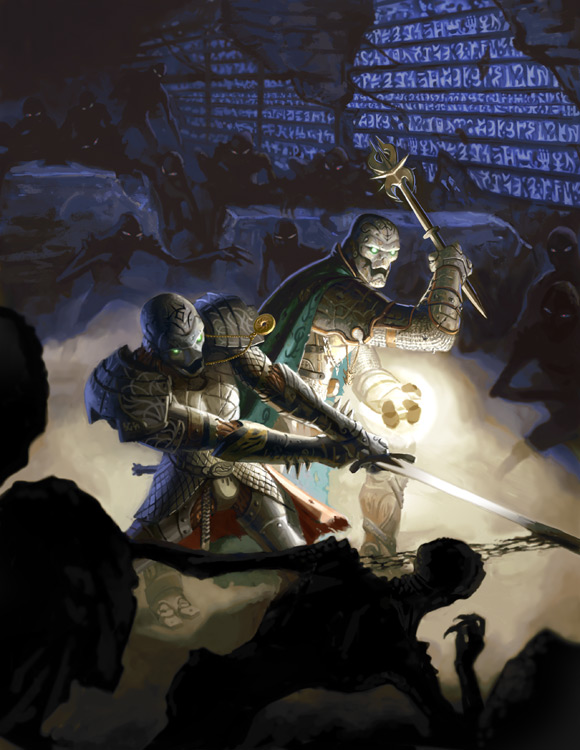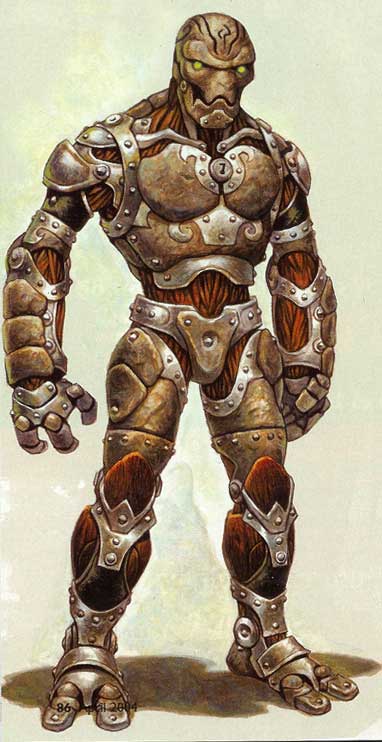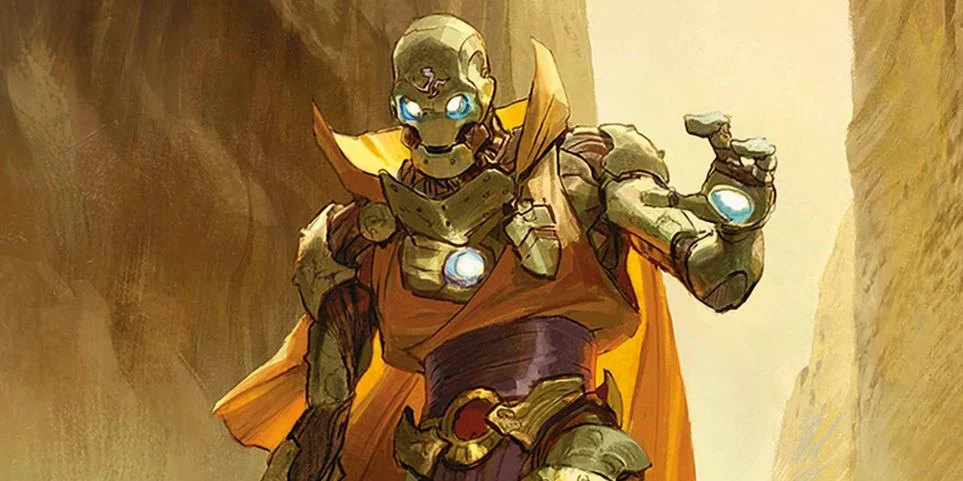Warforged
The warforged are constructs that were initially built for fighting in battles between rivaling wizards and artificers. After The War for Improvement had ended and their masters and the general knowledge of the war had long died, the magic used to create warforged remained, yet their purpose had changed from sole war machines now to valued servants and companions. Each warforged has their own personality, which is often unique for constructs.
Now with a wide array of purposes, the most gifted artificers attempt to create warforged with simple minds. Unbeknownst to them, however, the difficult rituals used to create warforged impart a greater wisdom and understanding into the constructs. Most warforged are oblivious to the intentions of the artificers, and those that come to realize what was desired of them sometimes play along, faithfully serving their master.
While all warforged possess the power of free will, many stray from the idea of complete independence for fear of upsetting their creator or master. Those that have broken free of this thought process, or those that have lost the one they served, begin to wander the world in pursuit of a purpose. Without someone to serve, the warforged branch off into different lifestyle choices, such as devoting themselves to a god, becoming a traveling mercenary, or falling into complete madness and going berserk.
Most warforged were assigned a combination of alphabetical and numerical designations for use in military service. Many of those still around from that lost era, adopted nicknames after the secret war, often given to them by their companions. As independent individuals, some have chosen new names as a way to express their path in life. A few take on human names, often the name of a fallen friend or mentor. A warforged created for a specific purpose may be given a name fitting for such a position.
Appearance
Warforged are formed from a blend of organic and inorganic materials. Root-like cords infused with alchemical fluids serve as their muscles, wrapped around a framework of steel or stone. Armored plates form a protective outer shell and reinforce joints. Warforged share a common facial design, with a hinged jaw and crystal eyes embedded beneath a reinforced brow ridge. A magical gemstone is set in the center of the warforged's forehead, which is seemingly the source of the warforged's sentience, containing all of its memories, its personality, and so on. Beyond these common elements of warforged design, the precise materials and build of a warforged vary based on the purpose for which it was designed, and many of the colors chosen for the warforged's gemstones or metal plating and so on are the choice of the creator. The crystal eyes of the warforged are crafted from gems of any kind, with the most lucrative of artificers preferring expensive, bedazzling gems. These eyes glow the color of the gem they are made from. While a warforged's rigid facial structure may not give away to any emotion, the warforged's eyes are able to convey some form of artificial humanity, their glowing eyes dimming or brightening to reveal some sort of vague emotional state. Aside from their rough steel and stone protections, some warforged are covered in intricate, decorative markings. Etched into their armored plates may be art pieces commissioned by well known artists, which are believed to impart some sort of wisdom or power to the warforged when it takes life. Some warforged have gold or silver filigree to denote a noble servitude, and some even have gemstones embedded into their bodies to give the semblance of some form of warforged caste. The typical warforged has a sexless body shape. Some warforged ignore the concept of gender entirely, while others adopt a gender identity. The more a warforged develops its individuality, the more likely it is to modify its body, seeking out an artificer to customize the look of its face, limbs, and plating.It has been revealed in recent years that to create a Warforged it requires materials and magic that is difficult to acquire for the most skilled mages and artificers. Despite that a small list of important materials are needed:
- Manual of Golems
- Components or the natural ability to use/cast the Magic Jar spell
- A scroll of Soul Cage
- Over 10k gold pieces in candles, aromatics, magic chalk
- And most importantly, a soul, willing or otherwise!
The Lost Age Wars
During the Third Age now called the Lost Age, as magic was becoming far more common among mortal races, those that practiced and manipulated the arcane began to build themselves grand fortresses for their own research and to house their vast numbers of servants. In this early age of sword and sorcery, the most powerful mages and magically inclined warriors were the ones that controlled civilizations, and would rapidly expand their reaches in pursuit of further arcane knowledge, bringing many to the edge of insanity. During this expansion, these grand figures frequently clashed, sending their loyal servants out into battle before resorting to slinging massive, potent spells at one another. This chaos ensued for a few wars before several archmages realized that the vast numbers they once ruled over had dwindled severely. Not only this, but the Cataclysm was beginning to take shape as the world began to crumble around them all. Desperate to continue their research despite this, the wizards researched the strong arcane magic required to create sentience. Their goal was to make artificial warriors for their battles. One such wizard, a haphazard human by the name of Khilad, began experimenting with creating constructs. This kind of magic had been well known before, with the creation of stone/wood homunculi and stone/wood golems, but Khilad desired to bend the arcane to a higher degree. After a few years of reclusive research and experimentation, he had created the first of the Warforged; a primitive design and limited functionality, yet a construct that possessed a higher intelligence than most others. In the next decades, Khilad's work had been refined, and he had amassed an army of constructs. Unfortunately for the careless artificer, however, his work had been stolen by a greedy servant, and had been sold off to other wizards who desired such an army. Soon enough, Khilad was not the only mage with an army of sentient, mechanical beings, and the mages resumed their tireless battles. The design of the warforged would change over the course of the Third Age, but their purpose had been clear from the beginning.An End to the War
Towards the end of the 3rd Age, a venerable Khilad had become enraged by the focus of the archmages. Their wars had still raged on, with the warforged at the helm of every battle, and the grand archmages did nothing to intervene in the pointless battling. Despite their expendable nature, Khilad had grown attached to his creations, and so he pulled from the deepest pocket of the arcane to unleash a fiery torment upon the world, killing many people who had participated in the endless war and setting his children, the warforged, free. The effort required to do this had disintegrated Khilad, but it was not in vain. After the destruction of the archmages, the final wars of the 3rd Age had abruptly come to an end, and countless warforged across Cevantia had come to the sudden realization that they were no longer in servitude to anyone in particular. Most wanted to set aside their weapons, but the Cataclysm looming over Cevantia gave them no chance to do so, as they finished one war for another. Many of the warforged were destroyed during the battle between the Leviathan's, the Gods, The Hells and the worlds inhabitants. Centuries later, as the warforged had faded into obscurity, archaeologists from the city of Venturas, found evidence of the Cataclysm and rediscovered the ancient rituals used to create the warforged, but had misinterpreted their original design. What followed was an influx of new, warforged who had been made as servants; lumberjacks, stonemasons, blacksmiths, and farmers.Warforged Personality
The warforged were built to serve and to fight. For most of their existence, warforged had a clearly defined function and were encouraged to focus purely on that role. The typical warforged shows little emotion. Many warforged embrace a concrete purpose, such as protecting allies, completing a contract, or exploring a land, and embrace this task as they once did war. However, there are warforged who delight in exploring their feelings, their freedom, and their relationships with others. Most warforged have no interest in religion, but some embrace faith and mysticism, seeking higher purpose and deeper meaning. Warforged often display an odd personality trait or two, given how new they are to the world.Features
- Ability Scores. Con +2, Choose any other +1
- Size. Medium. Warforged vary in height and weight depending on what purpose they serve, but they're most commonly the same height as humans.
- Speed. 30 feet.
- Age. A typical warforged traveling the world is between two and thirty years old. It remains a mystery how long the warforged can truly live and operate, as they have shown no signs of deterioration due to age. You are immune to magical aging effects.
- Alignment. Warforged are typically built with the aspects of order and discipline, tending toward law and neutrality, which they take comfort in. But some have absorbed the morality, or lack thereof, of the beings with which they served, and so they typically shadow what their former masters once had been.
- Construct. Your creature type is construct, rather than humanoid.
- Construct's Nature. You lack certain qualities that humanoids possess, such as being able to use potions or heal naturally over time, due to your constructed nature. You do not regain hit points normally when completing a long rest, and you must instead spend hit dice as you would when taking a short rest. A creature that has proficiency with smith's tools or tinker's tools can also restore 10 hit points to you for each hour of work, which can be accomplished over a long rest. A mending spell can also restore 3d8 hit points to you. You cannot die, and as such do not need to make death saving throws, however when you are reduced to 0 hit points you fall into disrepair, falling unconscious until you regain any number of hit points. While in disrepair, you can only regain hit points if a creature restores them to you.
- Constructed Resilience. You were created to have remarkable fortitude, represented by the following benefits:
- You have advantage on saving throws against being poisoned, and you have resistance to poison damage.
- You don't need to eat, drink, or breathe.
- You are immune to disease.
- You don't need to sleep, and magic can't put you to sleep.
- Constructed Resilience. You were created to have remarkable fortitude, represented by the following benefits:
- Sentry's Rest. When you take a long rest, you must spend at least six hours in an inactive, motionless state, rather than sleeping. In this state, you appear inert, but it doesn't render you unconscious, and you can see and hear as normal.
- Integrated Protection. Your body has built-in defensive layers, which can be enhanced with armor:
- At 1st level, your hit point maximum increases by 5, and whenever you gain a level, your hit point maximum increases by an additional 5.
- You gain a +1 bonus to AC.
- You can don only armor with which you have proficiency. To don armor, you must incorporate it into your body over the course of 1 hour, during which you remain in contact with the armor. To doff armor, you must spend 1 hour removing it. You can rest while donning or doffing armor in this way.
- As long as you aren't in disrepair, your armor can't be removed from your body against your will.
- Specialized Design. You gain one skill proficiency and one tool proficiency of your choice.
- Language. You can speak, read, and write Common and one other language of your choice. In addition, you also have the innate ability to read and decipher different arcane texts, such as those of a spell scroll or a magical effect.




